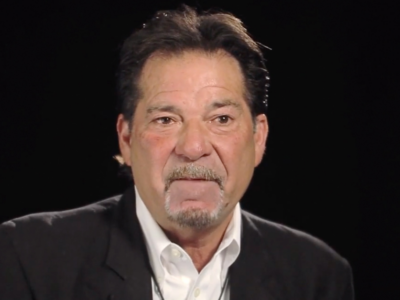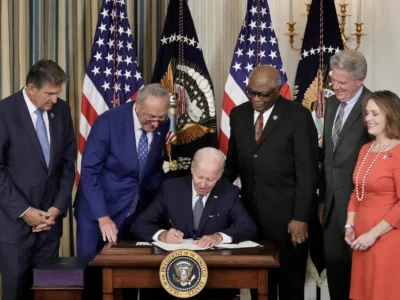Regulatory Policy
35 Major Climate Initiatives Under Biden
By any measure, it has been an eventful four years for climate policy, with billions in spending and many major regulations finalized. Here’s a timeline of the Top 30 actions.
In light of President Biden’s withdrawal from the 2024 presidential race yesterday, we thought it was appropriate to update this piece about the climate legacy of the Biden-Harris Administration. In his four years in office, Donald Trump rolled back essentially every existing federal policy to limit climate change. The picture under the Biden Administration has …
Continue reading “35 Major Climate Initiatives Under Biden”
CONTINUE READINGIs 2025 the Year of the Carbon Tax?
Carbon border adjustment mechanisms are increasingly the talk of Washington. UCLA Law’s Kimberly Clausing explains some of the options on the table.
There’s a big, important tax debate looming next year—one with opportunities and risks for climate policy, particularly the idea of a carbon tax. It can be hard to see this debate thanks to the daily churn of the 2024 presidential election, but it’s there on the horizon if you squint. For one thing, we’ll likely …
Continue reading “Is 2025 the Year of the Carbon Tax?”
CONTINUE READINGCalifornia can help meet its climate goals by removing SERP’s sunset date
By Molly Bruce, Dave Smith, Michael Kiparsky, Derek Hitchcock, Peter Van De Burgt, Sydney Chamberlin, Megan Cleveland
Many regulatory clearances like permits aim to guard against projects that pose harm to the environment. However, permitting can also undercut environmental restoration efforts. While restoration is designed to remedy environmental harms and improve resilience to climate change, permitting can substantially increase project costs and slow or altogether impede environmentally beneficial projects. Striking an effective …
Continue reading “California can help meet its climate goals by removing SERP’s sunset date”
CONTINUE READINGIs the Sky Falling? Chevron, Loper Bright, and Judicial Deference
Perplexed? Worried? Here’s a guide to a fraught area of law.
If you’re confused about the Supreme Court’s ruling, you’re not alone. Scholars will be discussing the recent ruling for years. It clearly will limit the leeway that agencies have to interpret statutes, meaning less flexibility to deal with new problems. But unlike many commentators, I don’t think the sky is falling. I was teaching environmental …
Continue reading “Is the Sky Falling? Chevron, Loper Bright, and Judicial Deference”
CONTINUE READINGThe “Silver Bullet” Required to Improve California’s Water Rights System: More & Better Data
California Lags Behind Other Western States in Obtaining Critically-Needed & Available Water Diversion Data
Recently I’ve posted stories about efforts to enforce California’s water laws in the face of efforts by some diverters to evade and ignore limits on their ability to privatize public water resources–especially in times of critical drought. One post focused on the federal government’s successful criminal prosecution of a San Joaquin Valley water district manager …
CONTINUE READINGReforming California’s Financial Penalties for Water Theft Will Create an Effective Deterrent
Overdue State Water Reform Legislation Likely Be Enacted in 2024–Finally
In a Legal Planet Post earlier this week, I recounted the saga of how federal prosecutors recently secured the criminal conviction of Dennis Falaschi, the former San Joaquin Valley water district general manager who oversaw the decades-long theft of millions of gallons of publicly-owned water from California’s Central Valley Project. That successful prosecution certainly qualifies …
CONTINUE READINGHypothetically Speaking: What if Trump Had Won in 2020?
In terms of climate policy, the short answer is “nearly total destruction.”
Trump’s end point from his first term — zeroing out federal climate action — would have been his starting point after reelection. The next steps would have been an effort to end state-level and private climate action, and a massive increase in oil & gas production and use.
CONTINUE READINGA Brazen California Water Heist Revealed, Prosecuted & Punished
San Joaquin Valley Water District Manager Pleads Guilty to Conspiring to Steal Public Water for 20+ Years
Recently, former Panoche Drainage District general manager Dennis Falaschi pled guilty in federal district court in Fresno to having conspired to steal millions of gallons of publicly-owned water from California’s Central Valley Project (CVP) for private gain. This surreptitious water theft apparently had been going on for well over two decades before Falaschi was finally …
Continue reading “A Brazen California Water Heist Revealed, Prosecuted & Punished”
CONTINUE READINGWhy a Bird in the Hand is Worth Two in the Bush — Especially When the Issue is Climate Change
Climate action is too urgent to insist on waiting for perfect solutions
It’s an ancient dispute: Should we compromise on half-measures, or hold out until we can get something a lot better? Idealists argue for holding out. Pragmatist argue that half a loaf is better than none. Rather than rehearse familiar arguments, I want to focus specifically on climate change. In my view, holding out for ideal …
CONTINUE READINGFlorida Governor DeSantis’ Head-In-The-Sand Climate Change Policies
New Florida Law Strikes Term “Climate Change” From State Laws, Promotes Fossil Fuels & Rejects Renewable Energy Projects
Florida Governor Ron DeSantis, in coordination with an equally myopic and partisan Florida Legislature, has approved new state legislation (HB 1645) that eliminates the term “climate change” from numerous existing Florida statutes that former Republican Governor Charlie Crist signed into law in 2008. The legislation, which takes effect on July 1st, is not just symbolic: …
Continue reading “Florida Governor DeSantis’ Head-In-The-Sand Climate Change Policies”
CONTINUE READING











